Resources
This carefully curated collection of resources will help you find packages and learning resources to help you on your R journey.

leaflet
Leaflet for R is an R package that makes it easy to integrate and control Leaflet maps in R. It provides interactive panning/zooming, the ability to compose maps using various map elements, and integration with Shiny apps. The package allows users to create maps from the R console or RStudio, embed maps in knitr/R Markdown documents and Shiny apps, and render spatial objects from the sp or sf packages. The package is widely used by websites, GIS specialists, and data visualization professionals.
Go to Resource
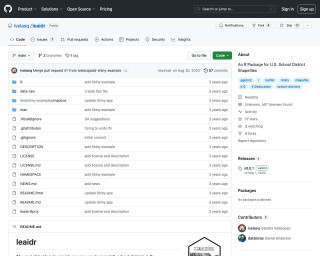
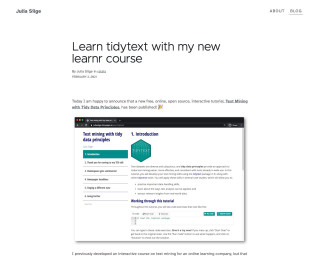
Learn tidytext with my new learnr course | Julia Silge
Learn tidytext with my new learnr course
Go to Resource
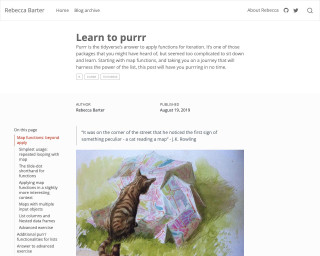
Learn to purrr
Learn the basics of the purrr package in R, which is part of the tidyverse and is used for iteration and manipulating lists.
Go to Resource

Learning R as a SAS user
This article provides valuable resources and tips for learners transitioning from SAS to R. It introduces the Sassy system of packages, which mimics familiar SAS outputs, and offers links to useful cheatsheets and videos for R learners. The author acknowledges the unique challenges faced by former SAS users and organizes tips from data loading to execution advice, catering to various skill levels. The article aims to ease the learning curve and enhance the R programming experience for individuals accustomed to SAS.
Go to Resource

Learning tidyselect
Learning tidyselect is a tutorial that covers various aspects of working with multiple columns using tidyselect in R. It explains the tidyselect selection helpers and how to use them with select(), where() and across(). It also provides examples and exercises to practice the concepts.
Go to Resource
Let's talk about joins
This blog post by Crystal Lewis delves into data joins, a fundamental process in data analysis when dealing with multiple datasets. The author clarifies horizontal and vertical joining methods, providing examples and explaining the nuances of left, right, full, and inner joins. Lewis emphasizes considering the type of join for specific research purposes and offers guidance on performing these operations, particularly in R, though the concepts apply across various programming languages. Importantly, the post outlines rules regarding variable naming and keys which are crucial for successful data merging.
Go to Resource
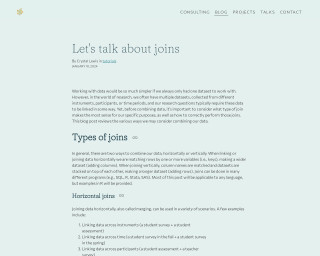
Let's talk about joins
This content provides a tutorial by Crystal Lewis on how to perform joins in data analysis, both horizontal and vertical, using SQL, R, Stata, SAS, or other programs. It explains different types of joins such as left, right, full, and inner joins, and the scenarios in which they might be used, like linking data across instruments, time, or participants. Lewis further details two important rules for horizontal joins related to variable naming and keys, ensuring the proper merging of datasets without duplication or data loss.
Go to Resource
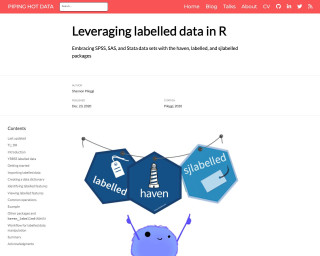
Leveraging labelled data in R
This blog post discusses how to leverage labelled data in R using the haven, labelled, and sjlabelled packages. It covers importing labelled data, creating a data dictionary, identifying labelled features, and common operations with labelled data. The post also provides an example and mentions other packages and workflow for labelled data manipulation.
Go to Resource

LibreTranslate API for R: translate, detect languages
libretranslateR is an R package that provides a binding to the LibreTranslate API, enabling users to perform translation tasks, detect languages, and list available languages for translation, all from within R. The package includes a user-friendly wizard for configuration, and allows connections to any LibreTranslate instance, offering flexibility and offline translation capabilities by hosting your own instance. Currently not available on CRAN, it can be installed directly from GitHub via the 'remotes' package, and comes with features like auto-detection of languages, translation without leaving R, and future enhancements like file translation and more user-friendly language names.
Go to Resource

Listening to complex tones using sine waves and toneR
The post details an experiment with auditory perception by converting chord patterns into complex tones through programming. Matt Crump describes using the R package {toneR} to synthesize chords as sums of sine waves at varying frequencies and amplitudes, resulting in complex tonal renderings. Initial code examples involve AI model 'Dreamshaper' generating art from prompts, with a musical focus. Subsequently, the tutorial shifts to R code for audio synthesis and processing. This exploration rekindles the author's previous academic work on complex tones and their perceptual effects, inviting readers to join in the auditory experiment.
Go to Resource
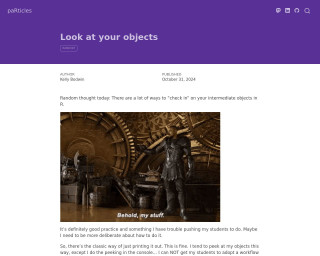
Look at your objects
The content discusses various methods to 'check in' on intermediate R objects during data analysis, emphasizing good practice for understanding data at each step. The author examines classic printing to the console, the use of semicolons, parenthesis for immediate output, inspecting data within pipelines, and summary functions like `glimpse()` that continue the pipeline. The post critiques each method's practicality, such as the cumbersomeness of multiline code or missing pipe symbols, and recommends best practices for students and analysts to monitor their data at different stages of analysis, using functions from libraries like tidyverse and magrittr.
Go to Resource